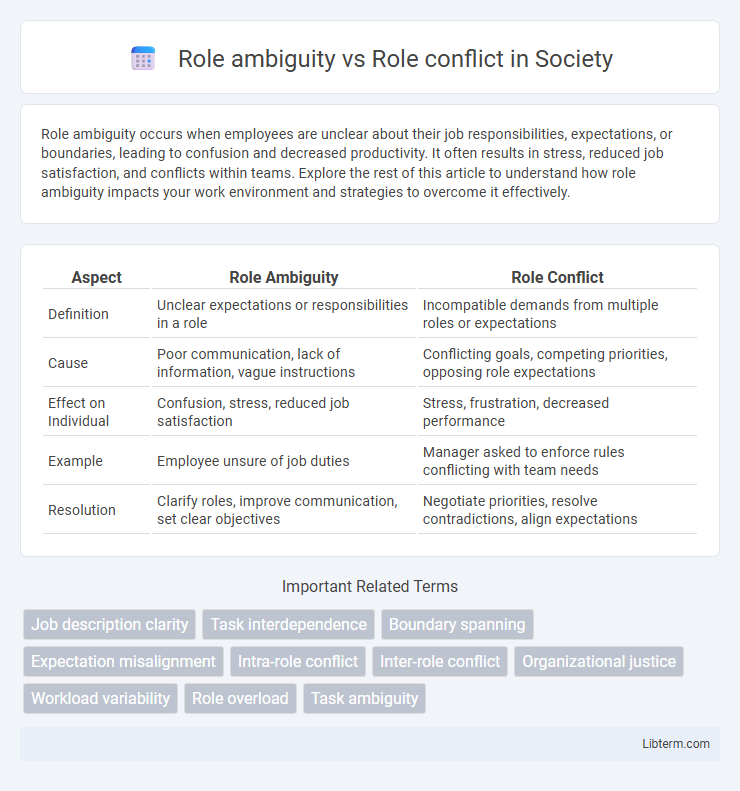Role ambiguity occurs when employees are unclear about their job responsibilities, expectations, or boundaries, leading to confusion and decreased productivity. It often results in stress, reduced job satisfaction, and conflicts within teams. Explore the rest of this article to understand how role ambiguity impacts your work environment and strategies to overcome it effectively.
Table of Comparison
| Aspect | Role Ambiguity | Role Conflict |
|---|---|---|
| Definition | Unclear expectations or responsibilities in a role | Incompatible demands from multiple roles or expectations |
| Cause | Poor communication, lack of information, vague instructions | Conflicting goals, competing priorities, opposing role expectations |
| Effect on Individual | Confusion, stress, reduced job satisfaction | Stress, frustration, decreased performance |
| Example | Employee unsure of job duties | Manager asked to enforce rules conflicting with team needs |
| Resolution | Clarify roles, improve communication, set clear objectives | Negotiate priorities, resolve contradictions, align expectations |
Introduction to Role Ambiguity and Role Conflict
Role ambiguity occurs when employees lack clear information about their job responsibilities, expectations, or the scope of their roles, leading to confusion and uncertainty. Role conflict arises when there are incompatible demands or expectations from different sources, forcing individuals to navigate contradictory priorities or instructions. Both phenomena significantly impact job satisfaction, performance, and organizational effectiveness.
Defining Role Ambiguity: Meaning and Characteristics
Role ambiguity refers to a situation in which an individual lacks clear information about their job expectations, responsibilities, or authority, leading to uncertainty and confusion. This condition is characterized by unclear role definition, vague performance criteria, and insufficient feedback from supervisors or colleagues. Role ambiguity often results in decreased job satisfaction, increased stress, and reduced organizational effectiveness.
Understanding Role Conflict: Types and Examples
Role conflict arises when individuals face incompatible demands within or between different roles, causing stress and reduced job performance. Common types include inter-role conflict, where expectations clash across multiple roles (e.g., employee vs. parent responsibilities), and intra-role conflict, which occurs when conflicting expectations exist within a single role (e.g., meeting deadlines vs. maintaining quality). Examples include a manager torn between enforcing company policies and supporting employee needs or a teacher balancing administrative duties with classroom instruction.
Key Differences Between Role Ambiguity and Role Conflict
Role ambiguity occurs when an individual lacks clear information regarding job expectations, responsibilities, or objectives, leading to uncertainty in task execution. Role conflict arises when an individual faces incompatible demands or expectations from different roles or stakeholders, causing stress and difficulty in prioritization. Key differences include ambiguity involving unclear role definitions, whereas conflict involves opposing role requirements that create tension.
Causes of Role Ambiguity in the Workplace
Role ambiguity in the workplace often arises from unclear job descriptions, inconsistent communication, and lack of defined expectations from supervisors. When employees are unsure about their responsibilities or performance standards, it can lead to confusion and reduced productivity. Unlike role conflict, which involves competing demands from multiple roles, role ambiguity centers on uncertainty within a single role's scope.
Triggers and Sources of Role Conflict
Role ambiguity occurs when job expectations are unclear, leading to confusion about responsibilities, whereas role conflict arises from incompatible demands or expectations within or between roles. Triggers of role conflict include contradictory instructions from multiple supervisors, overlapping job duties, and incompatible personal values versus organizational expectations. Sources of role conflict often stem from organizational restructuring, unclear communication channels, and conflicting stakeholder demands.
Psychological Impact of Role Ambiguity vs Role Conflict
Role ambiguity leads to increased stress and reduced job satisfaction as employees struggle to understand their responsibilities and expectations, causing uncertainty and anxiety. In contrast, role conflict generates psychological strain by forcing individuals to navigate competing demands and incompatible expectations, often resulting in emotional exhaustion and decreased motivation. Both phenomena impair mental well-being but through fundamentally different mechanisms of unclear versus contradictory role demands.
Effects on Team Performance and Productivity
Role ambiguity undermines team performance by causing confusion, reducing accountability, and increasing stress among members, which leads to lower productivity and project delays. Role conflict generates tension and disagreements within teams, disrupting collaboration and communication, resulting in decreased efficiency and compromised work quality. Clear role definitions and conflict resolution mechanisms are essential to maintaining high team productivity and cohesive performance.
Strategies to Address Role Ambiguity and Role Conflict
Role ambiguity and role conflict can be effectively addressed through clear communication, defined job responsibilities, and structured feedback mechanisms that enhance understanding of expectations. Implementing regular role clarification sessions and providing training on conflict resolution empower employees to navigate uncertainties and interpersonal discrepancies. Organizations benefit from fostering a culture of openness and support, which reduces stress and improves overall job performance.
Conclusion: Managing Roles for Organizational Success
Effective management of role ambiguity and role conflict is critical for enhancing employee performance and organizational success. Clear communication of job expectations and consistent role definitions reduce uncertainty and prevent overlapping responsibilities. Implementing structured support and feedback mechanisms fosters role clarity, minimizes conflict, and promotes a cohesive work environment.
Role ambiguity Infographic

 libterm.com
libterm.com